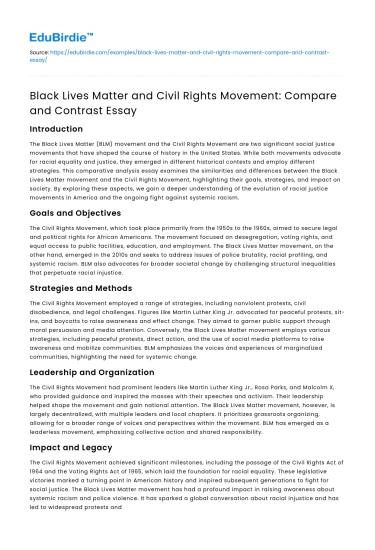Introduction
The Black Lives Matter (BLM) movement and the Civil Rights Movement are two significant social justice movements that have shaped the course of history in the United States. While both movements advocate for racial equality and justice, they emerged in different historical contexts and employ different strategies. This comparative analysis essay examines the similarities and differences between the Black Lives Matter movement and the Civil Rights Movement, highlighting their goals, strategies, and impact on society. By exploring these aspects, we gain a deeper understanding of the evolution of racial justice movements in America and the ongoing fight against systemic racism.
Goals and Objectives
The Civil Rights Movement, which took place primarily from the 1950s to the 1960s, aimed to secure legal and political rights for African Americans. The movement focused on desegregation, voting rights, and equal access to public facilities, education, and employment. The Black Lives Matter movement, on the other hand, emerged in the 2010s and seeks to address issues of police brutality, racial profiling, and systemic racism. BLM also advocates for broader societal change by challenging structural inequalities that perpetuate racial injustice.
Save your time!
We can take care of your essay
- Proper editing and formatting
- Free revision, title page, and bibliography
- Flexible prices and money-back guarantee
Strategies and Methods
The Civil Rights Movement employed a range of strategies, including nonviolent protests, civil disobedience, and legal challenges. Figures like Martin Luther King Jr. advocated for peaceful protests, sit-ins, and boycotts to raise awareness and effect change. They aimed to garner public support through moral persuasion and media attention. Conversely, the Black Lives Matter movement employs various strategies, including peaceful protests, direct action, and the use of social media platforms to raise awareness and mobilize communities. BLM emphasizes the voices and experiences of marginalized communities, highlighting the need for systemic change.
Leadership and Organization
The Civil Rights Movement had prominent leaders like Martin Luther King Jr., Rosa Parks, and Malcolm X, who provided guidance and inspired the masses with their speeches and activism. Their leadership helped shape the movement and gain national attention. The Black Lives Matter movement, however, is largely decentralized, with multiple leaders and local chapters. It prioritizes grassroots organizing, allowing for a broader range of voices and perspectives within the movement. BLM has emerged as a leaderless movement, emphasizing collective action and shared responsibility.
Impact and Legacy
The Civil Rights Movement achieved significant milestones, including the passage of the Civil Rights Act of 1964 and the Voting Rights Act of 1965, which laid the foundation for racial equality. These legislative victories marked a turning point in American history and inspired subsequent generations to fight for social justice. The Black Lives Matter movement has had a profound impact in raising awareness about systemic racism and police violence. It has sparked a global conversation about racial injustice and has led to widespread protests and calls for reform. BLM has also played a pivotal role in mobilizing young activists, utilizing social media to amplify marginalized voices and push for change.
Conclusion
While the Black Lives Matter movement and the Civil Rights Movement share a common goal of achieving racial equality and justice, they differ in their historical context, strategies, and organization. The Civil Rights Movement paved the way for significant legal and political victories, while the Black Lives Matter movement continues to challenge systemic racism in contemporary society. Both movements have played crucial roles in shaping the discourse on racial justice and have inspired generations to work towards a more equitable and inclusive future.






 Stuck on your essay?
Stuck on your essay?

